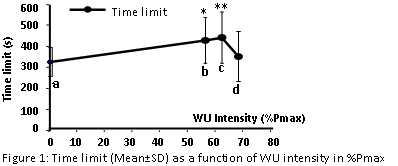|
METHODOLOGICAL
APPROACH FOR DETERMINING OPTIMAL ACTIVE WARM-UP INTENSITY: PREDICTIVE EQUATIONS
Mandengue Samuel H*.1,2, Miladi Imed2, Bishop
David3, Temfemo Abdou2, Cissé Fallou4, Ahmaidi
Saïd2.
1Laboratoire EA3300 APS et
Conduites Motrices, Université de Picardie Jules Verne, Amiens, France.
2 Sports and Exercise Physiology Unit, Faculty of Sciences,
University of Douala, Cameroon
3 Facoltà di Scienze Motorie, Università di Verona, via Casorati 43,
Verona I-37131, Italy.
4 Département de Physiologie, Faculté de Médecine,
Université Cheikh Anta Diop de Dakar, Sénégal.
* Corresponding and presenting author: shmandengue@yahoo.fr
|
|
Introduction
|
| Studies investigating
warm-up have resulted in conflicting and contradictory conclusions (1, 2). The
major purpose of the present study is to test a new methodological approach designed
to determine optimal warm up intensity and provide predictive models.
|
|
Methods
|
|
Two experiments were conducted. The first in Dakar (Senegal) with 9 university Institute of Sport level athletes; the second in Amiens France with 20 subjects of same category. The second experiment was a retest of the first for statistical validation. The methodological approach was based on a free field warm-up (FWU) with duration, intensity self-selected by athletes without limitation. During FWU heart rate was monitored and served to estimate the warm up (WU) intensity during an incremental trial of maximal power (Pmax) determination in laboratory. The FWU intensity and duration were replicated in the laboratory on cycle ergometer and referred to as the reference warm-up (RWU). From the RWU, two other WU intensities corresponding to a 10% intensity decrease (RWU-10) and 10% intensity increase (RWU+10) were devised; and their effect were assessed on time limit (Tlim) to exhaustion when cycling at 100% of individual (Pmax); and compared to no warm up (NWU). Physiological parameters: heart rate (HR), oxygen consumption (VO2),
blood lactate concentration [La-]) were measured during each test. The non parametric test of Wilcoxon was used after a one-way ANOVA with repeated measures, to compare data from tests FWU, NWU, RWU, RWU-10 and RWU+10 and to compare data of experiments in Senegal and France. The Spearman´s test was used to find correlation between variables.
|
|
Results
|
|
No significant difference was found in any of physiological and physical parameters, during free field warm-up in the two experiments. No significant difference was found in any of physiological parameters between FWU and RWU. RWU was found to be optimal in 56% of subjects, followed by RWU-10 (33%), RWU+10 (11%) and NWU (Fig. 1). RWU was located at 62±10 %Pmax, inducing an oxygen uptake corresponding to 75.6±10.4 %max, a HR increase of 77.7±7.2 % HRmax and a blood lactate concentration of 44.3±18.6 % [La-] max. Tlim during the performance of subsequent maximal trials, with and without warm-up, were 324.9 ± 69.3 s, 427.3 ± 108.6 s, 440.2 ± 121.5 s and 350.4 ± 118.1 s respectively for NWU, RWU-10, RWU and RWU+10. Performance (time limit) of the consecutive maximal trial was related to WU intensities by two linear interval regressions as follows: - y (Tlim (s)) = 1.8473x + 324.81 when x ≤ 62 ± 10 %Pmax; y (Tlim (s)) = -14.9x + 1364 when x ≥ 62 ± 10 %Pmax and to HR as follows: - y (Tlim (s)) = 1.4443x +324.77 when x ≤ 78.7 ± 5. 9 %HRmax; y (Tlim (s)) = -17.88x +1852.7 when x ≥ 78.7 ± 5. 9 %HRmax 
a = NWU, b = RWU-10, c = RWU, d = RWU+10 * Significant difference from NWU (p<0.01) ** Significant difference from RWU+10 (p<0.01) 62±10 %Pmax is the inflexion point and corresponds to the optimal warm-up (RWU)
|
|
Discussion/Conclusion
|
|
This study supports the idea that one of the best ways to
perform an optimal warm-up is self selection by athletes. It also validates the
approach of estimating the intensity of an optimal field warm-up using heart
rate monitoring; and finally this study shows that an optimal warm-up is
located at 62±10
%Pmax corresponding to 75.6±10.4 %VO2 max or 77.7±7.2
% HRmax.
|
|
References
|
|
1- Bishop D. (2003) Sports
Medicine. 33(6): 439–454.
2- Bishop D. (2003) Sports
Medicine. 33(7): 483–498.
|
|
| Les promoteurs d'URED |
 |
 |
| |
| Actualité |
|
L'actualité recente d'URED
|
|
|
| |
| Facebook Pr. Léopold Gustave Lehman |
| |
| EVENEMENT |
|
| |
| Forum |
|
|
| |
| Facebook Santec Afrique Centrale |
|
|
|